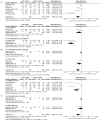Coating of Intestinal Anastomoses for Prevention of Postoperative Leakage: A Systematic Review and Meta-Analysis
- PMID: 35769150
- PMCID: PMC9235828
- DOI: 10.3389/fsurg.2022.882173
Coating of Intestinal Anastomoses for Prevention of Postoperative Leakage: A Systematic Review and Meta-Analysis
Abstract
Background: For several decades, scientific efforts have been taken to develop strategies and medical aids for the reduction of anastomotic complications after intestinal surgery. Still, anastomotic leakage (AL) represents a frequently occurring postoperative complication with serious consequences on health, quality of life, and economic aspects. Approaches using collagen and/or fibrin-based sealants to cover intestinal anastomoses have shown promising effects toward leak reduction; however, they have not reached routine use yet. To assess the effects of covering intestinal anastomoses with collagen and/or fibrin-based sealants on postoperative leakage, a systematic review and meta-analysis were conducted.
Method: PubMed, Web of Science, Cochrane Library, and Scopus (01/01/1964 to 17/01/2022) were searched to identify studies investigating the effects of coating any intestinal anastomoses with collagen and/or fibrin-based sealants on postoperative AL, reoperation rates, Clavien-Dindo major complication, mortality, and hospitalization length. Pooled odds ratios (ORs) with 95% confidence intervals (CIs) were calculated.
Results: Overall, 15 studies (five randomized controlled trials, three nonrandomized intervention studies, six observational cohort studies) examining 1,387 patients in the intervention group and 2,243 in the control group were included. Using fixed-effects meta-analysis (I 2 < 50%), patients with coated intestinal anastomoses presented significantly lower AL rates (OR = 0.37; 95% CI 0.27-0.52; p < 0.00001), reoperation rates (OR, 0.21; 95% CI, 0.10-0.47; p = 0.0001), and Clavien-Dindo major complication rates (OR, 0.54; 95% CI, 0.35-0.84; p = 0.006) in comparison to controls, with results remaining stable in sensitivity and subgroup analyses (stratified by study design, age group, intervention used, location of anastomoses, and indication for surgery). The length of hospitalization was significantly shorter in the intervention group (weighted mean difference (WMD), -1.96; 95% CI, -3.21, -0.71; p = 0.002) using random-effects meta-analysis (I 2 ≥ 50%), especially for patients with surgery of upper gastrointestinal malignancy (WMD, -4.94; 95% CI, -7.98, -1.90; p = 0.001).
Conclusion: The application of collagen-based laminar biomaterials or fibrin sealants on intestinal anastomoses can significantly reduce postoperative rates of AL and its sequelae. Coating of intestinal anastomoses could be a step toward effective and sustainable leak prevention. To assess the validity and robustness of these findings, further clinical studies need to be conducted.
Keywords: anastomotic leakage (AL); coated collagen patch; fibrin glue (FG); fibrin sealant; intestinal anastomoses.
Copyright © 2022 Cira, Stocker, Reischl, Obermeier, Friess, Burgkart and Neumann.
Conflict of interest statement
The authors declare that the research was conducted in the absence of any commercial or financial relationships that could be construed as a potential conflict of interest.
Figures






References
-
- Struecker B, Andreou A, Chopra S, Heilmann AC, Spenke J, Denecke C, et al. Evaluation of anastomotic leak after esophagectomy for esophageal cancer: typical time point of occurrence, mode of diagnosis, value of routine radiocontrast agent studies and therapeutic options. Dig Surg. (2018) 35(5):419–26. 10.1159/000480357 - DOI - PubMed
Publication types
LinkOut - more resources
Full Text Sources

